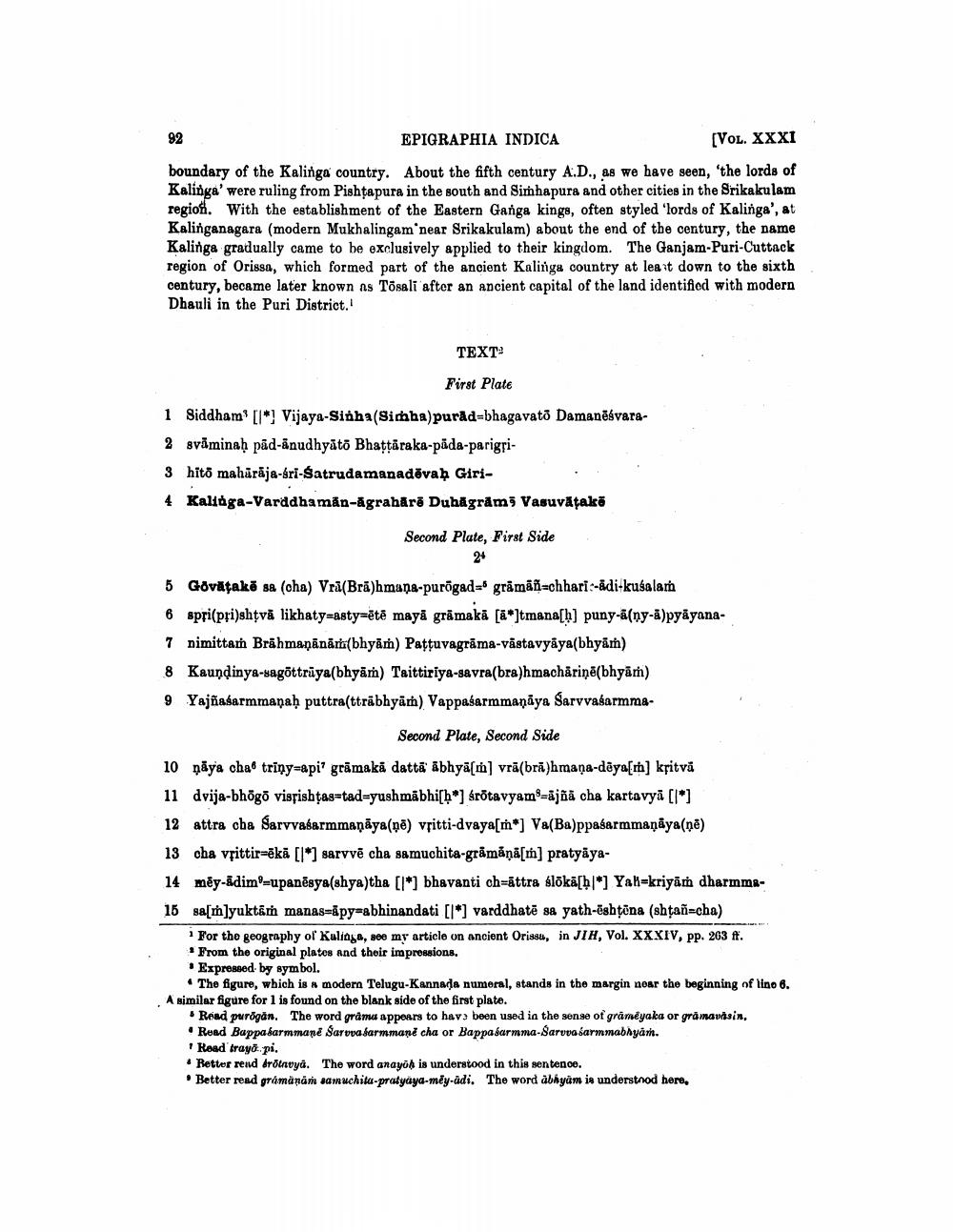________________
92
EPIGRAPHIA INDICA
[Vol. XXXI
boundary of the Kalinga country. About the fifth century A.D., as we have seen, 'the lords of Kalinga' were ruling from Pishtapura in the south and Simhapura and other cities in the Srikakulam region. With the establishment of the Eastern Ganga kings, often styled 'lords of Kalinga', at Kalinganagara (modern Mukhalingam near Srikakulam) about the end of the century, the name Kalinga gradually came to be exclusively applied to their kingdom. The Ganjam-Puri-Cuttack region of Orissa, which formed part of the ancient Kalinga country at least down to the sixth century, became later known as Tõsali after an ancient capital of the land identified with modern Dhauli in the Puri District.
TEXT"
First Plate
1 Siddham[l*) Vijaya-Sinha(Simha)purad=bhagavato Damanēsvara2 svāminaḥ pād-anudhyāto Bhattāraka-pāda-parigpi3 hito mahūrāja-sri-Satrudamanadēvaḥ Giri4 Kaltága-Varddha mån-ágrahārā Duhägräma Vasuvātako
Second Plate, First Side
5 Govățako sa (cha) Vrā(Brā)hmaņa-purõgada grāmāñ=chhari:-ådi-kušalam 6 spri(pri)shțvā likhaty=asty=ētē mayā grāmakā (ā*]tmana[h] puny-a(ny-a)pyāyana7 nimittain Brāhmaṇānāriu(bhyāṁ) Pațțuvagrāma-västavyāya(bhyam) 8 Kaundinya-yagöttrūya(bhyām) Taittiriya-savra(bra)hmachariņā(bhyām) 9 Yajñasarmmanaḥ puttra(ttrābhyam) Vappasarmmaņāya Sarvvasarmma
Second Plate, Second Side
10 ņāya chaø tring=api? grāmakā dattā ābhyā[m] vrā(brā)hmaņa-deya[m] ksitvā 11 dvija-bhögõ visçishtas-tad=yushmābhi[h*) srõtavyamo-ajñā cha kartavyā [l*] 12 attra cha Sarvvasarmmaņāya(ņē) vritti-dvaya[m*] Va(Ba)ppaśarmmaņāya(ņē) 13 cha vrittir=ēkā [l* sarvvē cha samuchita-grāmăņā[m] pratyaya14 mēy-ādimo=upanēsya(shya)tha [l*] bhavanti ch=āttra slökā[b]*] Yal=kriyām dharmma15 sa[m]yuktām manas=āpy=abhinandati [l*] varddhatē sa yath-ështēna (shtañ=cha)
For the geography of Kulinga, see my article on ancient Orissa, in JIH, Vol. XXXIV, pp. 203 ff. From the original plates and their impressions,
Expressed by symbol. • The figure, which is a modern Telugu-Kannada numeral, stands in the margin near the beginning of lino 6. A similar figure for 1 is found on the blank side of the first plate.
* Read purogan. The word grama appears to havs been used in the sense of grāměyaka or grāmavasin, • Road Bappalarmmane Sarvuafarmmané cha or Bappasarmma-Sarvvasarmmabhyan.
Read trayo.pi. • Retter rend drötnvya. The word anayoh is understood in this sentence. . Better read grámänām samuchita-pratyaya-mēy-adi. The word abhyam is understnod here,




